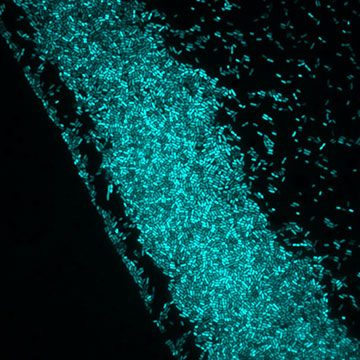
A sample of photo-controlled bacteria. [Image: Politecnico di Milano (Polytechnic University of Milan), Department of Physics]
Physicians know it’s hard to tell bacteria where to go or what to do. But a new light-driven signaling method could guide interactions between certain microbes and their biological hosts.
Researchers in Italy have demonstrated how to affect the interaction between antibiotics and microbes with a light-activated organic chemical that changes the electrical potential of bacterial membranes (Eur. Phys. J. Plus, doi:10.1140/epjp/s13360-025-06263-7). With no genetic modification necessary, the technique could help combat antibiotic resistance and even guide “bacterial robots” to deliver drugs within the body.
Potential for change
In recent years, biologists have learned that bacteria possess a membrane with electrical potential similar to that found in the cell membranes of larger plants and animals. External stimuli, such as the presence of chemicals that cause stress to the bacteria, can raise or lower the potential and change the internal functions of the microbes.
“This interplay between light and electrical signaling allows us to control key biological processes such as movement, biofilm formation and antibiotic sensitivity,” said study author Giuseppe Maria Paternò. “By manipulating the membrane potential on demand, we can influence antibiotic uptake and restore or even enhance the effectiveness of treatments against resistant strains.”
A team at the Polytechnic University of Milan tested a photo-sensitive chemical—a member of the azobenzene family—on a strain of Bacillus subtilis, a microbe often used as a model organism in microbiology experiments. As the bacterial stressor, the researchers chose two common antibiotics that work in different ways: kanamycin blocks bacteria’s production of essential proteins, leading to cellular death, while ampicillin inhibits the polymerization of microbial walls.
The combination of light and Ziapin2 significantly reduced the ability of kanamycin to kill off the microbes.
Adding light
The group treated the bacterial cultures with an azobenzene called Ziapin2, which alters the membrane potential of cells, and then mixed the cultures with either kanamycin or ampicillin. Half the samples were kept completely in the dark; the other samples were exposed to 470-nm-wavelength light for 10 minutes every half hour.
The researchers measured the populations of B. subtilis with optical density assays. The combination of light and Ziapin2 significantly reduced the ability of kanamycin to kill off the microbes. The team believes that the azobenzene undergoes an isomerization reaction due to the light exposure, which in turn lowers the capacitance in the membrane surrounding each microbe. On the other hand, the combination of Ziapin2 and ampicillin did not change its ability to kill bacteria in the presence or absence of light—both scenarios were highly toxic to the microbes.
The researchers hope that this work, extended to other classes of antibiotics and azobenzenes, will lead to more effective antimicrobial treatments for increasingly drug-resistant bacteria.

